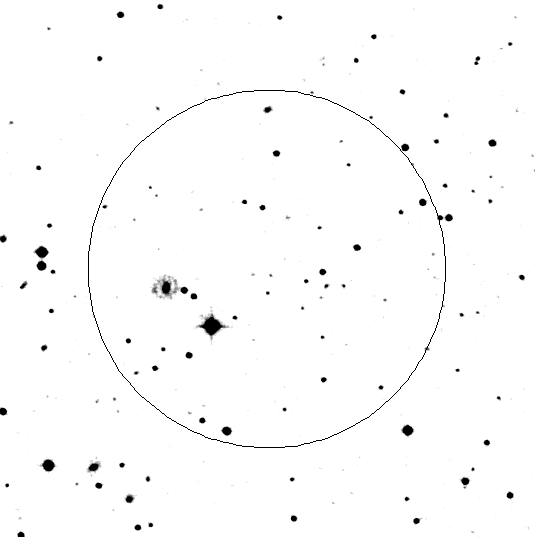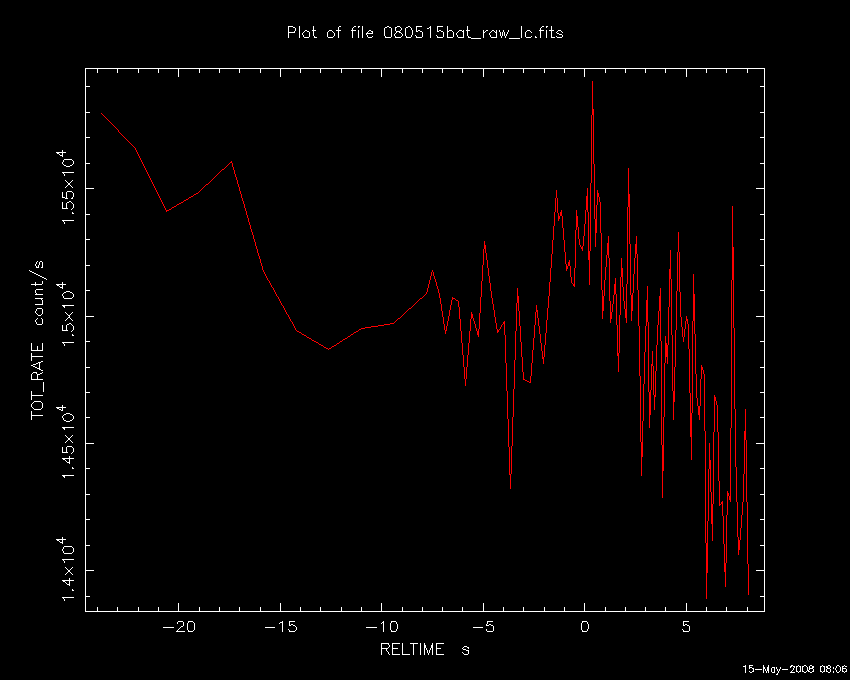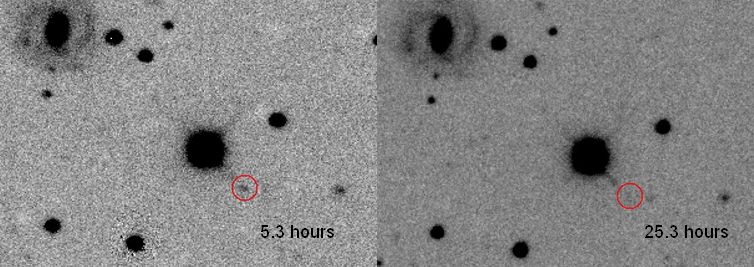- GCN/BACODINE POSITION NOTICE
TITLE: GCN/SWIFT NOTICE
NOTICE_DATE: Thu 15 May 08 06:01:47 UT
NOTICE_TYPE: Swift-BAT GRB Position
TRIGGER_NUM: 311658, Seg_Num: 0
GRB_RA: 3.150d {+00h 12m 36s} (J2000),
3.259d {+00h 13m 02s} (current),
2.501d {+00h 10m 00s} (1950)
GRB_DEC: +32.599d {+32d 35' 57"} (J2000),
+32.646d {+32d 38' 45"} (current),
+32.321d {+32d 19' 16"} (1950)
GRB_ERROR: 3.00 [arcmin radius, statistical only]
GRB_INTEN: 15450 [cnts] Image_Peak=180 [image_cnts]
TRIGGER_DUR: 2.048 [sec]
TRIGGER_INDEX: 264 E_range: 15-50 keV
BKG_INTEN: 183435 [cnts]
BKG_TIME: 21637.20 SOD {06:00:37.20} UT
BKG_DUR: 24 [sec]
GRB_DATE: 14601 TJD; 136 DOY; 08/05/15
GRB_TIME: 21673.81 SOD {06:01:13.81} UT
GRB_PHI: -69.87 [deg]
GRB_THETA: 41.61 [deg]
SOLN_STATUS: 0x203
RATE_SIGNIF: 8.42 [sigma]
IMAGE_SIGNIF: 7.05 [sigma]
MERIT_PARAMS: +1 +0 +0 +1 +1 +0 -100 +0 -69 +1
SUN_POSTN: 52.42d {+03h 29m 42s} +18.96d {+18d 57' 44"}
SUN_DIST: 45.89 [deg] Sun_angle= 3.3 [hr] (West of Sun)
MOON_POSTN: 179.78d {+11h 59m 08s} -3.26d {-03d 15' 53"}
MOON_DIST: 150.44 [deg]
MOON_ILLUM: 80 [%]
GAL_COORDS: 113.53,-29.56 [deg] galactic lon,lat of the burst (or transient)
ECL_COORDS: 16.98, 28.42 [deg] ecliptic lon,lat of the burst (or transient)
COMMENTS: SWIFT-BAT GRB Coordinates.
COMMENTS: This is a rate trigger.
COMMENTS: A point_source was found.
COMMENTS: This does not match any source in the on-board catalog.
COMMENTS: This does not match any source in the ground catalog.
COMMENTS: This is a GRB.
COMMENTS: Since the foreground interval count rate is less than the bkg interval (SAA exit), this is a questionable detection.
COMMENTS: This trigger occurred at longitude,latitude = 15.39,-19.93 [deg].
- red DSS finding chart
ps-file

- GCN NOTICE
TITLE: GCN/SWIFT NOTICE
NOTICE_DATE: Thu 15 May 08 06:06:34 UT
NOTICE_TYPE: Swift-BAT GRB Lightcurve
TRIGGER_NUM: 311658, Seg_Num: 0
GRB_RA: 3.150d {+00h 12m 36s} (J2000),
3.259d {+00h 13m 02s} (current),
2.501d {+00h 10m 00s} (1950)
GRB_DEC: +32.599d {+32d 35' 57"} (J2000),
+32.646d {+32d 38' 45"} (current),
+32.321d {+32d 19' 16"} (1950)
GRB_DATE: 14601 TJD; 136 DOY; 08/05/15
GRB_TIME: 21673.81 SOD {06:01:13.81} UT
TRIGGER_INDEX: 264
GRB_PHI: -69.87 [deg]
GRB_THETA: 41.61 [deg]
DELTA_TIME: 320.00 [sec]
TRIGGER_DUR: 2.048 [sec]
SOLN_STATUS: 0x203
RATE_SIGNIF: 8.42 [sigma]
IMAGE_SIGNIF: 7.05 [sigma]
LC_URL: sw00311658000msb.lc
SUN_POSTN: 52.43d {+03h 29m 42s} +18.96d {+18d 57' 46"}
SUN_DIST: 45.90 [deg] Sun_angle= 3.3 [hr] (West of Sun)
MOON_POSTN: 179.82d {+11h 59m 17s} -3.28d {-03d 17' 01"}
MOON_DIST: 150.46 [deg]
MOON_ILLUM: 80 [%]
GAL_COORDS: 113.53,-29.56 [deg] galactic lon,lat of the burst (or transient)
ECL_COORDS: 16.98, 28.42 [deg] ecliptic lon,lat of the burst (or transient)
COMMENTS: SWIFT-BAT GRB Lightcurve.
COMMENTS:
COMMENTS: The next comments were copied from the BAT_POS Notice:
COMMENTS: This is a rate trigger.
COMMENTS: A point_source was found.
COMMENTS: This does not match any source in the on-board catalog.
COMMENTS: This does not match any source in the ground catalog.
COMMENTS: This is a GRB.
COMMENTS: Since the foreground interval count rate is less than the bkg interval (SAA exit), this is a questionable detection.
COMMENTS: This trigger occurred at longitude,latitude = 15.39,-19.93 [deg].
COMMENTS: The 3rd packet (of 3) was missing in the lightcurve data stream.

- GCN Circular #7721
S. T. Holland (CRESST/USRA/GSFC), A. P. Beardmore (U Leicester),
P. A. Evans (U Leicester), E. A. Hoversten (PSU),
H. A. Krimm (CRESST/GSFC/USRA), C. B. Markwardt (CRESST/GSFC/UMD),
P. T. O'Brien (U Leicester), K. L. Page (U Leicester),
D. M. Palmer (LANL) and R. L. C. Starling (U Leicester) report on
behalf of the Swift Team:
At 06:01:13 UT, the Swift Burst Alert Telescope (BAT) triggered and
located GRB 080515 (trigger=311658). Swift could not slew to the burst
due to Sun constraint. The BAT on-board calculated location is
RA, Dec 3.150, +32.599 which is
RA(J2000) = 00h 12m 36s
Dec(J2000) = +32d 35' 57"
with an uncertainty of 3 arcmin (radius, 90% containment, including
systematic uncertainty). The BAT light curve from TDRSS was
truncated by the beginning of a Malindi downlink and
is further complicated as we were coming out of the SAA at the time, but
shows activity from the trigger time to the end of available data
at T+8s, with a peak count rate of ~500 counts/s (15-350 keV).
This burst is only 45.9 degrees from the Sun, so there will be no prompt
XRT or UVOT data. The field will be outside the Swift Sun observing
constraint tomorrow.
Burst Advocate for this burst is S. T. Holland (sholland AT milkyway.gsfc.nasa.gov).
Please contact the BA by email if you require additional information
regarding Swift followup of this burst. In extremely urgent cases, after
trying the Burst Advocate, you can contact the Swift PI by phone (see
Swift TOO web site for information: http://www.swift.psu.edu/too.html.)
- GCN Circular #7726
E. Fenimore (LANL), S. D. Barthelmy (GSFC), W. Baumgartner (GSFC/UMBC),
J. Cummings (GSFC/UMBC), N. Gehrels (GSFC), S. T. Holland (CRESST/USRA/GSFC),
H. Krimm (GSFC/USRA), C. Markwardt (GSFC/UMD), K. McLean (GSFC/UMD),
D. Palmer (LANL), T. Sakamoto (GSFC/UMBC), G. Sato (GSFC/ISAS),
M. Stamatikos (GSFC/ORAU), J. Tueller (GSFC), T. Ukwatta (GWU)
(i.e. the Swift-BAT team):
Using the data set from T-237 to T+962 sec from recent telemetry downlinks,
we report further analysis of BAT GRB 080515 (trigger #311658)
(Holland, et al., GCN Circ. 7721). The BAT ground-calculated position is
RA, Dec = 3.166, 32.564 deg, which is
RA(J2000) = 00h 12m 39.8s
Dec(J2000) = +32d 33' 49.9"
with an uncertainty of 1.6 arcmin, (radius, sys+stat, 90% containment).
The partial coding was 8%.
The mask-weighted light curve shows a single peak starting at ~T-5 sec,
peaking at ~T+2 sec, and ending at ~T+25 sec.
T90 (15-350 keV) is 21 +- 5 sec (estimated error including systematics).
The time-averaged spectrum from T-2.6 to T+24.0 sec is best fit by a power law
with an exponential cutoff. This fit gives a photon index 0.94 +- 1.21,
and Epeak of 25.0 +- 15.6 keV (chi squared 47.2 for 56 d.o.f.). For this
model the total fluence in the 15-150 keV band is 2.0 +- 0.3 x 10^-6 erg/cm2
and the 1-sec peak flux measured from T+1.37 sec in the 15-150 keV band is
3.9 +- 0.7 ph/cm2/sec. A fit to a simple power law gives a photon index
of 2.44 +- 0.19 (chi squared 53.8 for 57 d.o.f.). All the quoted errors
are at the 90% confidence level.
The results of the batgrbproduct analysis are available at
http://gcn.gsfc.nasa.gov/notices_s/311658/BA/
We also note that the fluence ratio in a simple power-law fit between the
25-50 keV band and the 50-100 keV band is 1.35. This fluence ratio is larger
than 1.32 which can be achieved in the Band function of alpha=-1.0, beta=-2.5,
and Epeak=30 keV. Thus, preliminary analysis shows that Epeak of the burst
is very likely around or below 30 keV. Therefore the burst can be classified
as an X-ray flash (e.g. Sakamoto et al. ApJ in press, arXiv:0801.4319).
- GCN Circular #7762
K.L. Page, A.P. Beardmore (U. Leicester) and S.T. Holland
(CRESST/USRA/GSFC) report on behalf of the Swift-XRT and UVOT teams:
A follow-up observation of GRB 080515 was performed about 1.5 days after
the initial trigger (Holland et al., GCN Circ. 7721), when the burst was
no longer Sun-constrained. An X-ray source was identified within the BAT
ground-calculated error circle (Fenimore et al., GCN Circ. 7726). A
further observation, 3.5 days later, confirmed that the source is fading,
with alpha = 1.0 +0.7/-0.5. We therefore believe this is the X-ray
afterglow of the GRB.
The position of this source is RA, Dec = 3.16343, 32.57894, which is
equivalent to:
RA(J2000) = 00 12 39.22
Dec(J2000) = +32 34 44.2
with an uncertainty of 3.8 arcsec (radius, 90% containment). This is 54
arcsec from the BAT position given by Fenimore et al. in GCN Circ. 7726.
A spectrum of the source can be fitted with a power-law of Gamma = 1.95
+/- 0.34, absorbed by the Galactic column of 4.65x10^20 cm^-2. This
spectrum, averaged over 1.5-6.6 days after the burst, has an observed
(unabsorbed) flux of 2.28x10^-13 (2.59x10^-13) erg cm^-2 s^-1.
The field was observed by UVOT with the v filter for 6262 s between
~1.5 and 2.4 days after the BAT trigger. The XRT error circle is
located in the scattered light halo of the B = 11.4 star TYC 2264-1051-1,
so it is not possible to constrain the presence of an afterglow in the
UVOT data.
This circular is an official product of the Swift-XRT and UVOT teams.
- GCN Circular #7765
Adria C. Updike, Ginger Bryngelson, and Dieter H. Hartmann (Clemson
University) report on behalf of the Clemson GRB Follow-Up Team:
We observed the field of GRB 080515 (GCN 7721, Holland et al.) twice using
the Kitt Peak 4m telescope + NEWFIRM in the J band under decent weather
conditions. The first observation was performed 5 hours and 20 minutes
after the burst; the second 29 hours and 20 minutes after the burst. We
detect a fading source inside the XRT error circle (GCN 7762, Page et al.)
at RA (J2000) = 00:12:39, Dec (J2000) = +32:34:41 (+/- 2 arcsec). We
therefore conclude that this is the afterglow of GRB 080515.
At 5.33 hours after the burst, the J-band magnitude of the afterglow was
16.4 +/- 0.1 mag (10 minute stack). 29.33 hours after the burst, the
magnitude was at our detection limit near 20.7 mag (20 minute stack). All
magnitudes were calibrated to the 2MASS catalog. An image of the
afterglow can be found here
http://www.ces.clemson.edu/~aupdike/GRB080515/080515.jpg .
This message may be cited.

- GCN Circular #7766
Adria C. Updike, Ginger Bryngelson, and Dieter H. Hartmann (Clemson
University) report on behalf of the Clemson GRB Follow-Up Team:
The J-band magnitude at 5.33 days should have read 19.6 +/- 0.1 mag. We
apologize for the mistake.
- GCN Report 141.1
GCN_Report 141.1 has been posted:
http://gcn.gsfc.nasa.gov/reports/report_141_1.pdf
by S.T. Holland
at CRESST/USRA/GSFC
titled: "Final Swift Observations of XRF 080515"
- D. Perley's Keck GRB Host
project: suggests potential host galaxy at z=2.47 (Ly-alpha).
The neighbouring object is at z=0.478 (OII, Hbeta, OIII).
![]() Previous IAU Circulars
Previous IAU Circulars 

